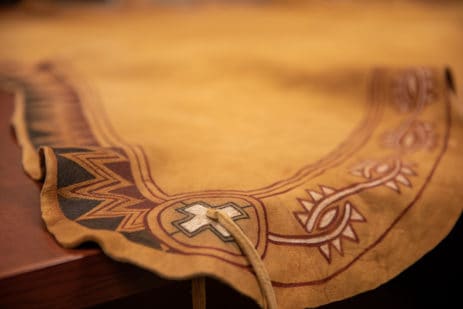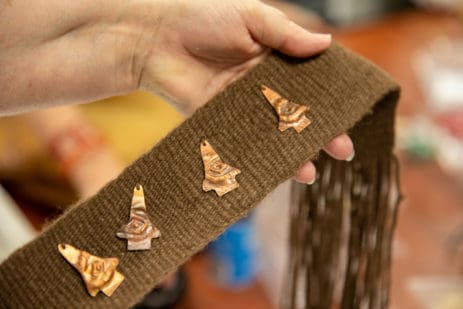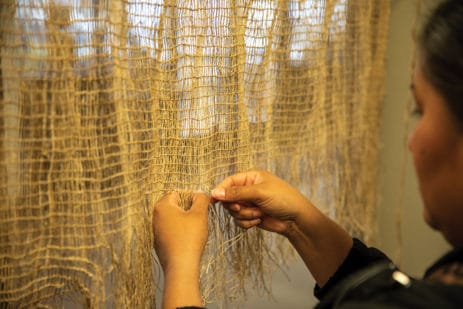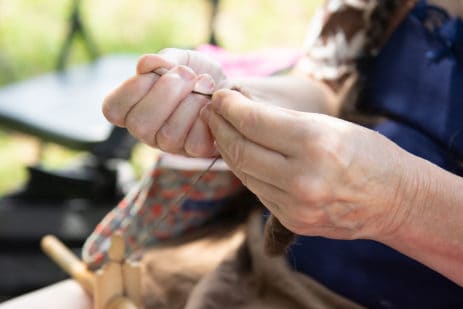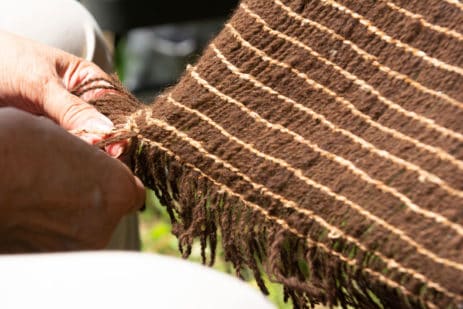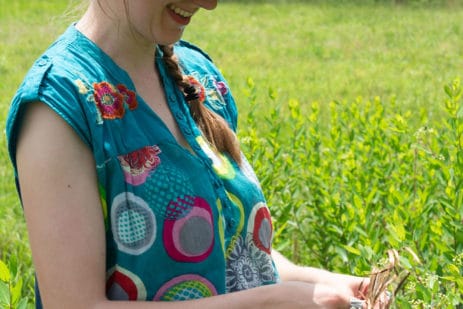Choctaw artists revive traditional practices for new Cultural Center
Published November 1, 2019
By Kellie Matherly
The new Choctaw Cultural Center is still under construction, but preparations for the traditional artwork featured throughout the grounds began almost a year ago. In November of 2018, the Choctaw Nation Cultural Services Department began partnering with 42 Choctaw artisans from all over the United States to create authentic clothing, tools, and household items from different periods in Choctaw history for dioramas and exhibits.
Traditional art is different from fine arts like painting and sculpture. In fact, the Choctaw language does not even have a word for art. The word imponna, to be skilled at something, comes closest. Traditional art focuses on skills and knowledge passed down through generations, and while this type of art may be beautiful, its function and usefulness in a culture is what makes it valuable. For this reason, it is important that Choctaw community members be involved in making artifacts for display.
“This is the Choctaw community telling its own story,” said Dr. Ian Thompson, Tribal Historic Preservation Officer and Senior Director of the Historic Preservation Department for the Choctaw Nation. According to Thompson, hundreds of hours have been spent researching Choctaw history and culture to ensure that every piece of traditional art “fully and accurately represents the time period.”
Getting the process just right for each of the artifacts has not always been easy. Over time, some traditional knowledge and skills have become rare or were lost altogether. “We are revitalizing practices people haven’t seen in 300 years,” says Stacey Halfmoon, Senior Director of the Cultural Center. In some cases, artists had to be taught the history, style, and context of the pieces they were asked to create in order to make them as historically accurate as possible.
One example is a hide tanning process that uses egg yolks to produce tvlhko, a type of leather that is edible as well as exceptionally strong and insulating. Because this particular method was fairly rare, Choctaw Nation Cultural Services partnered with a local tanner to teach classes on the process. The tvlhko students produced in these classes will be used in Cultural Center exhibits. Plus, the number of tvlhko makers has grown as a result.
Clothing and ceremonial regalia have also been commissioned for the center. Jennifer Byram, Research Assistant for the Historic Preservation Department, has been working alongside other Choctaw tribal members to make twined skirts, from traditional materials such as stinging nettle. Another skirt was made from gathered, processed, and spun bison wool and dogbane yarns, which were also hand-twined. “Reawakening textile traditions with our textile community for the Cultural Center has been a great honor for us all. Some of the clothing may seem foreign to visitors, but by making and sharing these items, we hope to renew understanding of Choctaw textiles that have thousands of years of nearly forgotten history,” Byram said.
In addition to the buffalo wool and other plant fiber skirts, the Cultural Center will house a cape made from turkey feathers and another made from racoon skins, both created from designs based on centuries-old Choctaw and European descriptions. Both capes are in New York being fitted to the mannequins that will wear them in the Cultural Center. The raccoon skin cape will be fitted to a mannequin of Tuscalusa, who was chief around the same time the description of the cape was written.
Visitors to the Cultural Center will see exhibits highlighting Choctaw metalwork, jewelry and beadwork as well.
Brent Deramus, a Choctaw coppersmith living in Colorado, has contributed 18 pieces of stamped copper for a woven buffalo wool belt. Deramus, who learned his craft as part of his recovery from addiction, drew his inspiration from research he did on the importance of copper to the Choctaw people. “I like to make things that are different and unique,” Deramus said. “There’s so much more to our art in the past few hundred years.” Deramus, whose copperwork has won many awards, hopes to contribute other pieces to the Cultural Center as well.
Choctaw tribal member and U.S. park ranger Roger Amerman worked on several historical research projects in his career that helped inspire the beadwork and clothing he created for the Cultural Center. Although Choctaw clothing of the early 1800s is his specialty, Amerman was also asked to collaborate on a diorama depicting Choctaw life in the 1500s. He knew it would be a challenge because he could only use materials available before European contact. With Dr. Thompson’s guidance, Amerman used elk hide, tiny shells, and pigments he ground himself from minerals for his contributions to the diorama. “This has pushed me to learn more about my tribe and be a better artist,” he said.
When asked what contributing to the Cultural Center meant to him, Amerman added, “I am more than pleased and honored to give back to my nation … I can’t think of a better way to honor my ancestors and our unborn.”
Traditional art is just one of the many features that will make the Cultural Center special. The overall goal is to create an immersive encounter with Choctaw life, past and present. Over 100 interviews combined with community surveys and input from Choctaw leaders helped shape the guest experience from start to finish. “The art will combine with videos, interviews, and food to tell the whole story,” said Thompson.
When it is finished, the grounds of the Cultural Center will total approximately 98,000 square feet and house dioramas, landscapes, a living village, and a mound based on Nvnih Waiya, the Mother Mound in the Choctaw homelands in Mississippi. The center will also have a café featuring traditional Choctaw cuisine.
